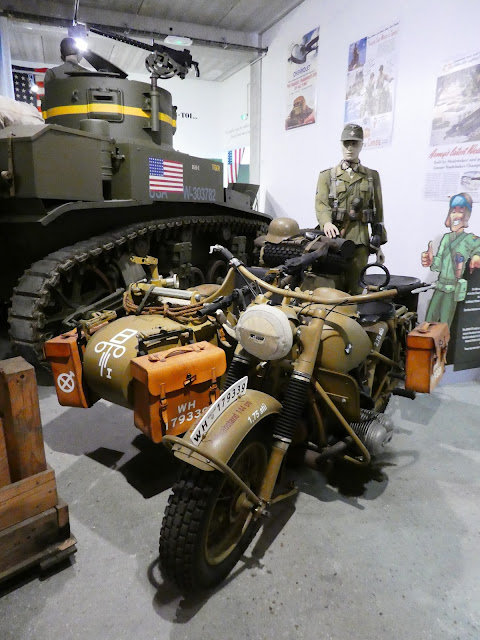
In 2016, while touring around South Australia ahead of the Bay to Birdwood classic car rally, Shelly and I stopped in at the Greenock Aviation Museum. This extraordinary museum is the private collection of one man, Lincoln Nitschke, who has picked up dozens of World War Two and inter-war year aircraft over the years. All the aircraft are stored, partly dismantled, in two enormous but crowded sheds. It is an amazing effort to save old aircraft that otherwise would be scrapped. By my recollection he had 2 De Havilland Mosquito bombers, 3 Avro Anson training and communications aircraft, one De Havilland Vampire jet fighter (complete), 1 Commonwealth Aircraft Corp (CAC) Boomerang fighter (very rare), 2 CAC Wirraway fighter/bombers (very rare), 1 De Havilland Dove airliner, 1 Mustang fighter (complete) and a BEC Canberra bomber (complete). These are just the planes I can remember. I was totally dumbstruck how he'd managed to acquire them, transport them here, dismantle them and reassemble in his sheds. Truly remarkable.

Inside the museum. In the centre is a Vampire jet fighter.

Vampire close up

Rear view of the Vampire.

In the centre is an Avro Anson and in the foreground a Commonwealth Aircraft Corporation (CAC) Wirraway.

De Havilland Dove. This type was used as an airliner and a military transport during the 1950s.

The 'wooden wonder', the De Havilland Mosquito. De Havilland had been working on a light bomber design since the mid-1930s, without much success. However, the Allied defeat during the Battle of France revealed that Britain's current fleet of light bombers, such as the ill-fated Fairey Battle, were no match for the German Luftwaffe. In 1940 the RAF authorised De Havilland to produce a prototype of their new light bomber. A feature of the new aircraft was the minimal use of strategic materials, such as aluminum, in favour of wood framed construction under a wood veneer skin. The use traditional woodworking techniques meant that components could be outsourced to woodworking shops and vehicle coach-builders. Given the attrition rate of aircraft during the Battle of France and Battle of Britain, little consideration was given to the type's longevity. Surprisingly, the Mosquito proved to be a tough aircraft that was capable of taking a lot of punishment.

The Mosquito performed exceptionally well in a variety roles. It was used as a heavy fighter, light bomber, pathfinder, night fighter, reconnaissance and as a fast transport. It served in the RAF, RAAF and RCAF right through to the 1950s, by which time the type's wooden construction began to fail and they were withdrawn from service. By the 1960s the technical skills to repair the Mosquito were no longer available and those that had been preserved were unrestorable as the glue used in their outer skin had degraded and their wooden spars and frames were rotten. The few flying Mosquitos are modern reproductions built using the original techniques.

Avro Lincoln upper turret.

Avro Anson. Developed in the mid 1930s as an airliner, the Anson was used in a variety of military roles ranging from transport, coastal patrol, multi-engine trainer, radio / radar training. After the war many were converted back into airliners and transporters. Many served into the 1960s until the Department of Civil Aviation became concerned that the type's wooden main wing spars were no longer airworthy and de-registered all flying examples in 1962.
https://www.goodall.com.au/photographs/ansons/ansons.html


Avro Anson nose and cockpit.

Airspeed Oxford was another twin engined airliner that was used in support roles during the Second World War. It was not as successful or widely used as the Avro Anson.

CAC Wirraway. Built by the Commonwealth Aircraft Corporation as a two seat fighter bomber. Although they served with Australian forces in the Pacific War, they were no match for the Japanese Zero.

The Commonwealth Aircraft Corporation Boomerang fighter. The Wirraway had been based on the US Havard trainer, but the Boomerang was an entirely Australian designed and built aircraft. It proved to be slower and less maneuverable than even contemporary Allied fighters, let alone the Japanese Zero. It nevertheless was used in second line service, freeing up American built fighters for front-line service.

BAC Canberra. Canberra's for Australian service were built under license in Australia. They remained in service from the 1950s right through to the late 1980s, by which time they had been relegated to reconnaissance and training roles.

The Canberra and Mustang are packed in the open where they can be seen from the road.



P51 Mustang fighter

In one of the back sheds is a collection of agricultural machinery.

Greenock Aviation Museum is a private collection and the $3 entry fee doesn't do much meet maintenance costs. If you're in the wine country north of Adelaide, do pop passed the museum and say hello Lincoln and his amazing collection.
https://www.tripadvisor.com.au/Attraction_Review-g495017-d8089010-Reviews-Greenock_Aviation_Museum-Greenock_Barossa_Valley_South_Australia.html
Here is a great link to a collection of photos of abandoned military aircraft in the 1960s.
https://www.goodall.com.au/photographs/wrecks-relics/wrecksnrelics.html
For a link to our travels through Victoria and South Australia on our way to Bay to Birdwood, see here:
http://heinkelscooter.blogspot.com/2017/10/travels-with-dkw.html


























































